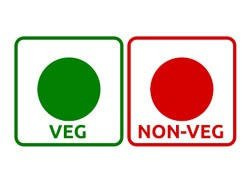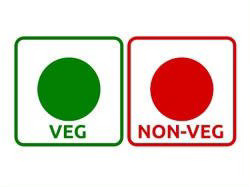I vividly remember sitting in my sixth grade cafeteria, eating my home-packed roti sabji, when a classmate came and tried to shove a chicken nugget into my mouth. I kept him at bay, but was startled. Was it so shocking to him that I was vegetarian?
As I described in my last post, my family originates from the Vaishya caste in India, specifically the Bania mercantile subcaste. While different Hindu sub-groups like the Kshatriyas (warriors) often consume meat, Banias are primarily vegetarian. Our ancestors deemed that the act of commerce and business doesn’t require the protein consumption — and therefore justify animal slaughter — the way that being a warrior might.1 (I do agree, but my ancestors have made bulking season quite difficult.)
In my years in India, I saw a clear distinction between vegetarian and non-vegetarian food. It seemed simple: “veg” food had a green dot, “non-veg” food had a red dot. “Green dot” food also excluded fish and eggs. After coming back to the U.S., I tried following “green dot” vegetarianism, but the distinction wasn’t always so obvious. Were cafeteria cookies made with eggs okay? There was no dot to guide me.
In the U.S. and “Western world” more broadly, various vegetarian movements have existed on the fringes of culture. The term was first adopted by the Vegetarian Society in Manchester, England in 1847 (another reason I’m a Manchester United fan), before which it was called the Pythagorean diet after the Greek philosopher who believed that animal slaughter is immoral.2
In 1906, muckraker Upton Sinclar published The Jungle, which exposed the inhumane and unsanitary practices of the meatpacking industry, convincing many Americans to stop eating meat.3 There was even a short-lived American Vegetarian Party, which nominated candidates for President from 1947 through 1964.4 Since the 1970s, environmental concerns around 200+ billion pounds of yearly methane emissions from animal agriculture5, as well as health risks associated with meat consumption, have become primary motivators for becoming vegetarian.
Unlike what the dots indicate, vegetarianism is not a binary but a spectrum. It includes pescetarians (fish allowed), lacto-vegetarians (dairy but not egg), lacto-ovo-vegetarians (dairy and egg both allowed), flexitarians, and — of course — vegans.6 For ease, I will refer to this collective spectrum as “vegetarians.”
Even in just my social circles, there are diverse reasons for being vegetarian. Many of my Indian Americans friends grew up vegetarian for the same socioreligious concerns around animal slaughter. My friend Sophie decided to go vegan after watching documentaries about the environmental impacts of animal agriculture. A colleague of mine became vegetarian after seeing the “faces” on the fish served in a visit to China.
My dear friend Bobo (of biking fame) grew up eating meat in Macedonia, but was also influenced by climate change. He shared his unique trial-and-error path to becoming flexitarian. “I first said I am going to be vegetarian until the meat is going to be thrown away. But if you’re feeling hungry for meat, any meat is technically going to be thrown away. Then I tried being pescetarian, but then I found myself eating fish like once or twice a day. So then I said, I will be vegetarian except for when I travel. But what does travelling really mean?” Now, Bobo has landed on a system where he allows himself 25 meat meals every year, and keeps a “meat log” of these special occasions.
Despite the variety of reasons, vegetarians made up only ~4% of the American population in 2010.7 After all, vegetarianism isn’t an easy sell. One friend — who wishes to stay anonymous — grew up with a vegan mom. Like me, she came face-to-face with a chicken nugget in a school cafeteria, but had the opposite reaction. “I grew up eating soy nuggets at home. On the first day of first grade, I tried the cafeteria chicken nuggets, and thought they were amazing. When my mom said I couldn’t eat them, I decided I would live a lie.”
In 2019, a decade after my cafeteria incident, I met Impossible Foods CEO Pat Brown on Georgetown’s campus. Their revolutionary plant-based meat products were meant to offer non-vegetarians an equivalent substitute, thus hopefully reducing their meat consumption. They also had the side benefit of allowing vegetarians like me to finally eat a “chicken” nugget guilt-free.
In the years since, I’ve cooked Impossible Burgers for countless “red dot” friends. They are usually pleasantly surprised (not because of my cooking skill), but I couldn’t convince anyone to stop eating meat. In general, the plant-based meat industry has struggled to get repeat customers, primarily because consumers don’t think the taste is equivalent to meat.8 So, when I learned about cultivated meat, I was fascinated.
Cultivated meat is made from real animal cells grown in a lab.9 It can offer a “real meat” eating experience without requiring animal slaughter or methane emissions at the scale of conventional meat production. Through an externship program I got the chance to work for UPSIDE Foods, the world’s leading cultivated meat company. I was inspired by their effort to scale such an innovative product, and am deeply grateful I could play a very small role in supporting them.
But when my parents found out, they were horrified. I showed them videos of the process and how different UPSIDE’s facilities were from slaughterhouses, but they would not budge. They had queasily tolerated plant-based burgers, but cultivated meat seemed “red dot.” And given their reaction, I wasn’t sure where I stood. Would I eat cultivated meat?
As I’ve experienced, the vegetarian spectrum has very different reactions to cultivated meat. Those like my parents, who have grown up believing any type of meat is out of bounds, may struggle to accept cultivated meat. Others who have converted more recently, like Bobo, would be open to trying it. Friends like Sophie may want to learn more about the ethical and environmental impacts before making a decision.
To be clear, vegetarians are not the target audience of cultivated meat. However, it is just one of many innovative food products that we will find in our menus and grocery store aisles. Other products like insect protein might also make some vegetarians curious and others very uncomfortable. But we shouldn’t just look away.
As these new trends challenge our food norms, it’s important to consider not just the “what,” but the “why” behind our principles. Even if we may not choose to consume these products ourselves, we should understand their purpose and promote those we believe are moving the world closer to our values.
Simply following a dot isn’t enough.
The opinions expressed in this article are solely my own and do not express the views or opinions of any current or former employer.
Hardiman, David (1996). Feeding the Baniya: Peasants and Usurers in Western India. Oxford University Press. pp. 62–92.
https://time.com/3958070/history-of-veganism/
I’m reading The Jungle a century later and the details are just as horrifying.
https://www.pbs.org/food/the-history-kitchen/evolution-vegetarianism/#:~:text=In%201947%20a%20short%2Dlived,doctor%20and%20restaurateur%20John%20Maxwell.
“A single cow produces between 154 to 264 pounds of methane gas per year. Not counting for the emissions of any other livestock, 1.5 billion cattle, raised specifically for meat production worldwide, emit at least 231 billion pounds of methane into the methane into the atmosphere each year (Our World in Data).” https://www.epa.gov/snep/agriculture-and-aquaculture-food-thought#:~:text=A%20single%20cow%20produces%20between,(Our%20World%20in%20Data).
“Green dot” vegetarianism, a term I believe I have fully made up, correlates best with lacto-vegetarianism.
https://faunalytics.org/study-shows-7-3-million-americans-are-vegetarians/
According to the Good Food Institute, in 2022 plant-based meat only had an 18% household penetration and 63% repeat purchase rate. 46% of consumers said the reason they did not purchase it again was because of taste. https://gfi.org/wp-content/uploads/2023/01/2022-Plant-Based-State-of-the-Industry-Report.pdf
To learn more about the science of cultivated meat, check out: https://gfi.org/science/the-science-of-cultivated-meat/#:~:text=What%20is%20cultivated%20meat%3F,and%20farm%20animals%20for%20food.








